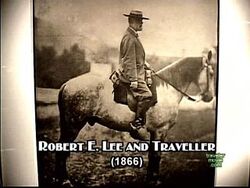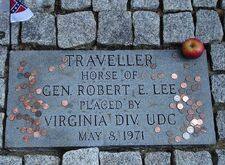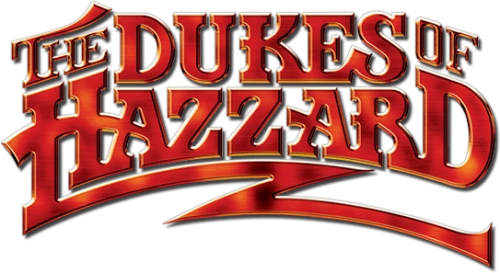- For Grady Hagg's car, see Traveller.

Traveller (1857–1871) was Confederate General Robert E. Lee's most famous horse during the American Civil War.
Birth and war service[]
Traveller, originally named Jeff Davis, was born near the Blue Sulphur Springs, in Greenbrier County, Virginia (now West Virginia), raised by Andrew Johnston. An American Saddlebred, he was of the Gray Eagle stock, and, as a colt, took the first prize at the Lewisburg, Virginia, fairs in 1859 and 1860. As an adult gelding, he was a sturdy horse, 16 hands high and 1,100 pounds (500 kg), iron gray in color with black points, a long mane and flowing tail.
In the spring of 1861, a year before achieving fame as a Confederate general, Robert E. Lee was commanding a small force in western Virginia. The quartermaster of the 3rd Virginia Infantry, Captain Joseph M. Broun, was directed to "purchase a good serviceable horse of the best Greenbrier stock for our use during the war." Broun purchased the horse for $175 (approximately $4,000 in 2008)[1] from Andrew Johnston's son, Captain James W. Johnston, and named him Greenbrier. Major Thomas L. Broun, Joseph's brother recalled that Greenbrier
General Lee took a great fancy to the horse. He called him his "colt", and predicted to Broun that he would use it before the war was over. After Lee was transferred to South Carolina, Joseph Broun sold the horse to him for $200 in February, 1862. Lee named the horse "Traveller" (spelling the word with a double 'l' in British style).
Traveller was a horse of great stamina and was usually a good horse for an officer in battle because he was difficult to frighten. He could sometimes become nervous and spirited, however. At the Second Battle of Bull Run, while General Lee was at the front reconnoitering dismounted and holding Traveller by the bridle, the horse became frightened at some movement of the enemy and, plunging, pulled Lee down on a stump, breaking both of his hands. Lee went through the remainder of that campaign chiefly in an ambulance. When he rode on horseback, a courier rode in front leading his horse.
After the war, Traveller accompanied Lee to Washington College in Lexington, Virginia. He lost many hairs from his tail to admirers (veterans and college students) who wanted a souvenir of the famous horse and his general. Lee wrote to his daughter Mildred that "The boys are plucking out his tail, and he is presenting the appearance of a plucked chicken."
Death and burials[]

Traveller's grave at the Lee Chapel
In 1870, during Lee's funeral procession, Traveller was led behind the caisson bearing the General's casket, his saddle and bridle draped with black crepe. Not long after Lee's death, in 1871, Traveller stepped on a nail and developed tetanus. There was no cure, and he was euthanized to relieve his suffering. Traveller's grave at the Lee Chapel
Traveller was initially buried behind the main buildings of the college, but was unearthed by persons unknown and his bones were bleached for exhibition in Rochester, New York, in 1875/1876. In 1907, Richmond journalist Joseph Bryan paid to have the bones mounted and returned to the college, named Washington and Lee University since Lee's death, and they were displayed in the Brooks Museum, in what is now Robinson Hall. The skeleton was periodically vandalized there by students who carved their initials in it for good luck. In 1929, the bones were moved to the museum in the basement of the Lee Chapel, where they stood for 30 years, deteriorating with exposure.
Finally in 1971, Traveller's remains were buried in a wooden box encased in concrete next to the Lee Chapel on the Washington & Lee campus, a few feet away from the Lee family crypt inside, where his master's body rests. The stable where he lived his last days, directly connected to the Lee House on campus, traditionally stands with its doors left open; this is said to allow his spirit to wander freely. The 24th President of Washington & Lee (and thus a recent resident of Lee House), Dr. Thomas Burish, caught strong criticism from many members of the Washington & Lee community for closing the stable gates in violation of this tradition. Burish later had the doors to the gates repainted in a dark green color, which he referred to in campus newspapers as "Traveller Green."
The base newspaper of the United States Army's Fort Lee, located in Petersburg, Virginia, is named Traveller.
Traveller remains in the hearts and minds of Washington and Lee students to this day, and is the namesake of the University's Safe Ride Program. Students are known to exclaim "Call Traveller and you will get home safely."
In popular media[]
- Moonrunners (1975) featured a dirt-track racing car with a Confederate flag on the roof, named "Traveller".
- For The Dukes of Hazzard TV series, Traveller was transformed into the painted up 1969 Dodge Charger, known as the "General Lee".
Bibliography[]
- Southern Historical Society Papers, Richmond, Va., January–December, 1890.
- Lee's Horses at Stratford Hall website
- General Lee's Traveller, On the Campus of Washington and Lee, brochure published by the Lee Chapel Museum, 2005.
- Magner, Blake A. Traveller & Company, The Horses of Gettysburg. Gettysburg, PA: Farnsworth House Military Impressions, 1995. ISBN 0-9643632-2-4.
